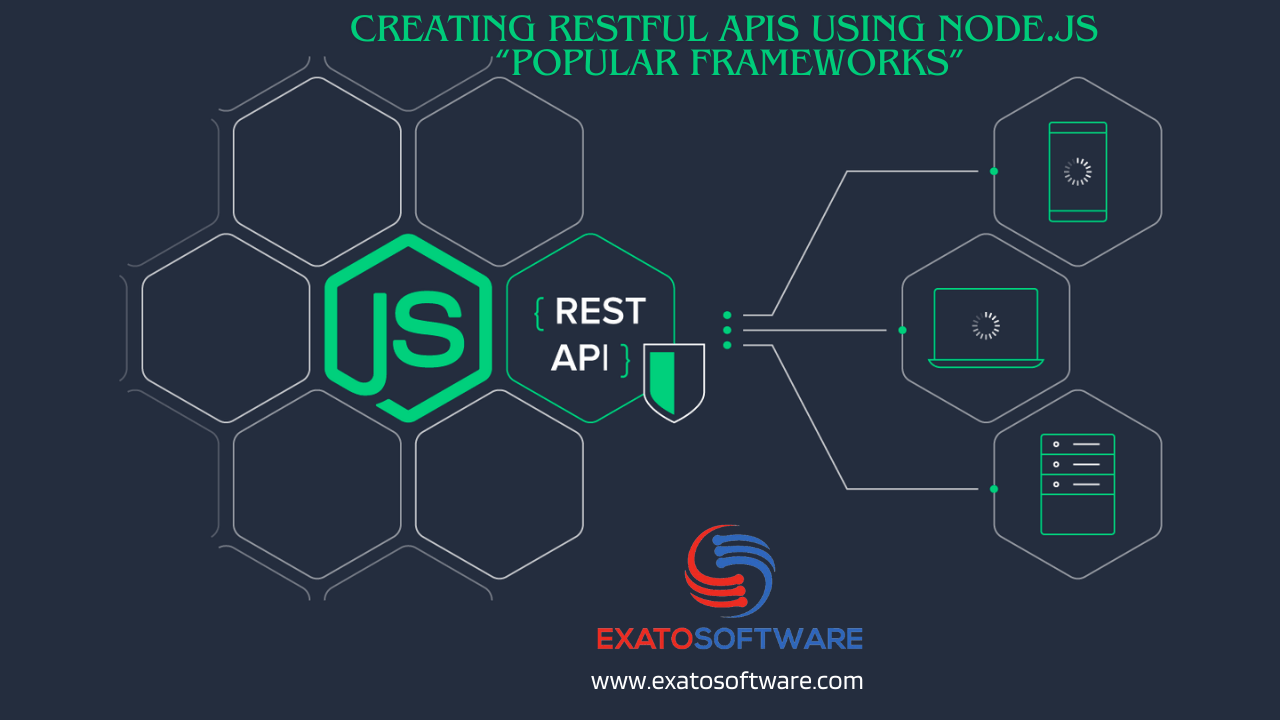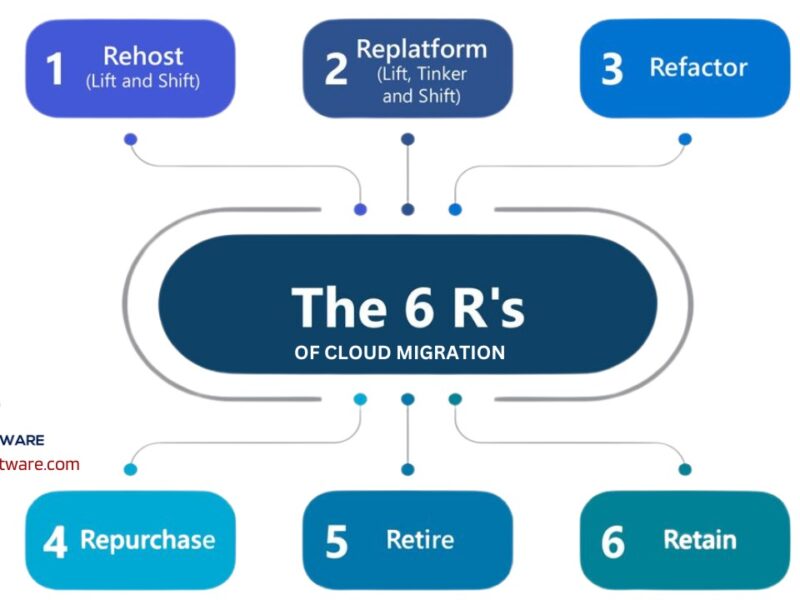There are several popular frameworks for building RESTful APIs using Node.js. Each has its own features, strengths, and use cases.
Popular Frameworks
- Express.js: Express is one of the most widely used and minimalist web frameworks for Node.js. It provides a robust set of features for web and mobile applications and has a large and active community.
- Koa.js: Koa is a more modern and lightweight framework developed by the creators of Express. It uses async/await syntax, making it more readable and easier to work with asynchronous code.
- Hapi.js: Hapi is a powerful and flexible framework for building web applications and services. It focuses on configuration-driven development and has built-in support for input validation, authentication, and more.
- Restify: Restify is designed specifically for building REST APIs. It is lightweight, fast, and contains features like versioning, request parsing, and automatic handling of CORS.
- Adonis.js: Adonis is a full-featured web framework that follows the MVC pattern. It comes with a powerful ORM (Object Relational Mapping) called Lucid, making it a good choice for building not just APIs but also full-stack applications.
- NestJS: While NestJS is often associated with TypeScript, it can also be used with plain JavaScript. It follows the modular architecture and is heavily inspired by Angular. It’s well-suited for building scalable and maintainable applications.
- LoopBack: LoopBack is a highly extensible, open-source Node.js framework that enables you to quickly build dynamic end-to-end REST APIs. It comes with a powerful CLI for scaffolding and is often used for building enterprise-grade applications.
Choose a framework based on your project requirements, familiarity with the framework, and the specific features it offers. Express.js is a common choice due to its simplicity and wide adoption, but other frameworks might be better suited for specific use cases.
Why Restful APIs?
RESTful APIs can contribute to making Node.js applications robust and dependable in several ways. Following are compelling reason why you should use these.
- Separation of Concerns: RESTful APIs promote a clear separation of concerns between the frontend and backend of an application. By structuring your Node.js application with a RESTful API, you create a modular architecture that allows frontend and backend components to evolve independently. This separation enhances maintainability and scalability.
- Scalability: RESTful APIs support stateless communication, meaning each request from a client to the server contains all the information needed to understand and fulfill that request. This statelessness makes it easier to scale Node.js applications horizontally by adding more server instances or distributing the load across multiple servers.
- Interoperability: RESTful APIs use standard HTTP methods (GET, POST, PUT, DELETE), and they typically communicate using widely accepted data formats like JSON. This standardization promotes interoperability, allowing different parts of your application (or even different applications) to communicate seamlessly. It also makes it easier to integrate third-party services or allow other developers to consume your API.
- Flexibility in Frontend Development: Separating the frontend and backend through a RESTful API enables the frontend to be developed independently. This flexibility allows frontend developers to use different technologies and frameworks, as long as they can communicate with the API using HTTP requests.
- Statelessness and Reliability: RESTful APIs are designed to be stateless, meaning each request is independent of any previous request. This statelessness simplifies the application’s behavior and makes it more predictable and reliable. If a request fails, the client can retry it without worrying about the state on the server.
- Data Validation and Consistency: RESTful APIs often implement validation mechanisms to ensure that incoming data is correct and consistent. By validating data on the server side, you reduce the risk of errors and maintain data integrity, contributing to the robustness of your Node.js application.
- Security: RESTful APIs can implement security measures such as authentication and authorization, ensuring that only authorized users or systems can access certain resources. This helps protect sensitive data and adds an additional layer of security to your application.
- Documentation and Discoverability: Well-designed RESTful APIs often come with comprehensive documentation that makes it easier for developers to understand how to use the API. This documentation improves the discoverability of available endpoints, reducing the learning curve for developers who want to integrate with or extend your application.
- Testing and Debugging: Separating the backend logic into a RESTful API allows for more straightforward testing. Developers can use tools like Postman or automated testing frameworks to test API endpoints independently, facilitating the identification and resolution of issues.
- Middleware and Extensibility: Node.js and RESTful frameworks often support the use of middleware, allowing developers to inject custom logic into the request-response cycle. This extensibility makes it easier to add features, handle cross-cutting concerns, and modify behavior without directly altering the core logic of the application.
By adopting RESTful principles and designing a well-architected API in a Node.js application, you can achieve modularity, scalability, interoperability, reliability, and security, all of which contribute to the robustness and dependability of the overall system.
Create Restful APIs with ExpressJS
Creating a RESTful API with Express in Node.js involves several steps. Below is a step-by-step guide to help you get started:
Step 1: Set Up Your Project
Create a new directory for your project and navigate into it using the command line:
“`bash
mkdir express-rest-api
cd express-rest-api
“`
Initialize a new Node.js project:
“`bash
npm init -y
“`
Step 2: Install Express
Install Express as a dependency for your project:
“`bash
npm install express
“`
Step 3: Create the Express App
Create a file named `app.js` (or any other preferred name) in your project directory.
“`javascript
// app.js
const express = require(‘express’);
const app = express();
const port = 3000;
app.use(express.json()); // Middleware to parse JSON requests
// Define a sample route
app.get(‘/’, (req, res) => {
res.send(‘Hello, World!’);
});
app.listen(port, () => {
console.log(`Server is running at http://localhost:${port}`);
});
“`
Step 4: Test Your Express App
Run your Express application using the following command:
“`bash
node app.js
“`
Visit `http://localhost:3000` in your web browser, and you should see the “Hello, World!” message.
Step 5: Create API Endpoints
Expand your `app.js` file to include API endpoints. For example:
“`javascript
// app.js
// … (previous code)
const users = [
{ id: 1, name: ‘John Doe’ },
{ id: 2, name: ‘Jane Doe’ },
];
// Get all users
app.get(‘/users’, (req, res) => {
res.json(users);
});
// Get a specific user by ID
app.get(‘/users/:id’, (req, res) => {
const userId = parseInt(req.params.id);
const user = users.find(u => u.id === userId);
if (user) {
res.json(user);
} else {
res.status(404).json({ error: ‘User not found’ });
}
});
// … (remaining code)
“`
Step 6: Handle HTTP Methods
Expand your API to handle other HTTP methods like POST, PUT, and DELETE for CRUD operations:
“`javascript
// app.js
// … (previous code)
// Create a new user
app.post(‘/users’, (req, res) => {
const newUser = req.body;
users.push(newUser);
res.status(201).json(newUser);
});
// Update an existing user
app.put(‘/users/:id’, (req, res) => {
const userId = parseInt(req.params.id);
const updatedUser = req.body;
// Update user in the array or return a 404 if not found
const index = users.findIndex(u => u.id === userId);
if (index !== -1) {
users[index] = { …users[index], …updatedUser };
res.json(users[index]);
} else {
res.status(404).json({ error: ‘User not found’ });
}
});
// Delete a user
app.delete(‘/users/:id’, (req, res) => {
const userId = parseInt(req.params.id);
// Remove user from the array or return a 404 if not found
const index = users.findIndex(u => u.id === userId);
if (index !== -1) {
const deletedUser = users.splice(index, 1);
res.json(deletedUser[0]);
} else {
res.status(404).json({ error: ‘User not found’ });
}
});
// … (remaining code)
“`
Step 7: Install Nodemon (Optional)
Nodemon is a tool that helps develop Node.js based applications by automatically restarting the node application when file changes are detected.
“`bash
npm install -g nodemon
“`
Run your application using nodemon:
“`bash
nodemon app.js
“`
Now, your Express app will automatically restart whenever you make changes to the code.
Step 8: Test API Endpoints
Use tools like curl, Postman, or your browser to test the different API endpoints you’ve created. For example:
– To get all users: `GET http://localhost:3000/users`
– To create a new user: `POST http://localhost:3000/users` (with JSON payload)
– To update a user: `PUT http://localhost:3000/users/:id` (with JSON payload)
– To delete a user: `DELETE http://localhost:3000/users/:id`
This is how you can create Restful API using ExpressJS.
Create RESTful API with Nest.js
Creating RESTful APIs with Nest.js involves several steps. Nest.js is a powerful and modular framework that follows the MVC (Model-View-Controller) pattern and is built with TypeScript. Here’s a step-by-step guide to help you create a simple RESTful API with Nest.js:
Step 1: Install Nest CLI
Nest.js provides a CLI that makes it easy to create and manage Nest.js applications. Install the Nest CLI globally:
“`bash
npm install -g @nestjs/cli
“`
Step 2: Create a New Nest.js Project
Create a new Nest.js project using the Nest CLI:
“`bash
nest new nest-rest-api
“`
Navigate into the project directory:
“`bash
cd nest-rest-api
“`
Step 3: Create a Controller
In Nest.js, controllers handle incoming requests and define the routes for your API. Generate a controller using the Nest CLI:
“`bash
nest generate controller users
“`
This command creates a `users.controller.ts` file in the `src/users` directory. Open this file and define your API endpoints:
“`typescript
// src/users/users.controller.ts
import { Controller, Get, Post, Body, Param, Put, Delete } from ‘@nestjs/common’;
@Controller(‘users’)
export class UsersController {
private users = [
{ id: 1, name: ‘John Doe’ },
{ id: 2, name: ‘Jane Doe’ },
];
@Get()
findAll(): any[] {
return this.users;
}
@Get(‘:id’)
findOne(@Param(‘id’) id: string): any {
const userId = parseInt(id, 10);
const user = this.users.find(u => u.id === userId);
if (!user) {
throw new NotFoundException(‘User not found’);
}
return user;
}
@Post()
create(@Body() user: any): any {
this.users.push(user);
return user;
}
@Put(‘:id’)
update(@Param(‘id’) id: string, @Body() updatedUser: any): any {
const userId = parseInt(id, 10);
const index = this.users.findIndex(u => u.id === userId);
if (index === -1) {
throw new NotFoundException(‘User not found’);
}
this.users[index] = { …this.users[index], …updatedUser };
return this.users[index];
}
@Delete(‘:id’)
remove(@Param(‘id’) id: string): any {
const userId = parseInt(id, 10);
const index = this.users.findIndex(u => u.id === userId);
if (index === -1) {
throw new NotFoundException(‘User not found’);
}
return this.users.splice(index, 1)[0];
}
}
“`
Step 4: Test Your API
Run your Nest.js application:
“`bash
npm run start
“`
Visit `http://localhost:3000/users` in your web browser or use tools like curl or Postman to test your API endpoints.
Step 5: Optional – Install TypeORM for Database Integration
If you want to integrate a database, you can use TypeORM, a popular TypeScript-based ORM. Install TypeORM and a database driver of your choice (e.g., SQLite, PostgreSQL, MySQL):
“`bash
npm install @nestjs/typeorm typeorm sqlite3
“`
Configure TypeORM in your `app.module.ts` file and create an entity for your data model.
Step 6: Optional – Add Validation
Nest.js provides validation decorators to validate incoming request data. You can use class-validator and class-transformer to perform validation.
“`bash
npm install class-validator class-transformer
“`
Step 7: Optional – Add DTOs (Data Transfer Objects)
Create DTOs to define the shape of your data when sending or receiving requests.
Step 8: Optional – Add Authentication and Authorization
Nest.js supports various authentication and authorization strategies. You can integrate Passport.js for authentication and use guards for authorization.
Step 9: Optional – Add Middleware and Interceptors
Nest.js allows you to use middleware for global processing and interceptors for manipulating the data flow.
This is how you can create Restful APIs using Nest.JS.
Restful APIs using Koa.js
Now let us check how we can do the same with Koa.JS. This is a web framework that uses async/await syntax.
Step 1: Initialize Your Project
Create a new directory for your project and navigate into it using the command line:
“`bash
mkdir koa-rest-api
cd koa-rest-api
“`
Initialize a new Node.js project:
“`bash
npm init -y
“`
Step 2: Install Koa
Install Koa as a dependency for your project:
“`bash
npm install koa koa-router
“`
Step 3: Create the Koa App
Create a file named `app.js` in your project directory.
“`javascript
// app.js
const Koa = require(‘koa’);
const Router = require(‘koa-router’);
const bodyParser = require(‘koa-bodyparser’);
const app = new Koa();
const router = new Router();
app.use(bodyParser()); // Middleware to parse JSON requests
// Define a sample route
router.get(‘/’, (ctx) => {
ctx.body = ‘Hello, World!’;
});
app.use(router.routes());
app.use(router.allowedMethods());
const port = 3000;
app.listen(port, () => {
console.log(`Server is running at http://localhost:${port}`);
});
“`
Step 4: Test Your Koa App
Run your Koa application using the following command:
“`bash
node app.js
“`
Visit `http://localhost:3000` in your web browser, and you should see the “Hello, World!” message.
Step 5: Create API Endpoints
Expand your `app.js` file to include API endpoints. For example:
“`javascript
// app.js
// … (previous code)
const users = [
{ id: 1, name: ‘John Doe’ },
{ id: 2, name: ‘Jane Doe’ },
];
// Get all users
router.get(‘/users’, (ctx) => {
ctx.body = users;
});
// Get a specific user by ID
router.get(‘/users/:id’, (ctx) => {
const userId = parseInt(ctx.params.id);
const user = users.find(u => u.id === userId);
if (user) {
ctx.body = user;
} else {
ctx.status = 404;
ctx.body = { error: ‘User not found’ };
}
});
// … (remaining code)
“`
Step 6: Handle HTTP Methods
Expand your API to handle other HTTP methods like POST, PUT, and DELETE for CRUD operations:
“`javascript
// app.js
// … (previous code)
// Create a new user
router.post(‘/users’, (ctx) => {
const newUser = ctx.request.body;
users.push(newUser);
ctx.status = 201;
ctx.body = newUser;
});
// Update an existing user
router.put(‘/users/:id’, (ctx) => {
const userId = parseInt(ctx.params.id);
const updatedUser = ctx.request.body;
// Update user in the array or return a 404 if not found
const index = users.findIndex(u => u.id === userId);
if (index !== -1) {
users[index] = { …users[index], …updatedUser };
ctx.body = users[index];
} else {
ctx.status = 404;
ctx.body = { error: ‘User not found’ };
}
});
// Delete a user
router.del(‘/users/:id’, (ctx) => {
const userId = parseInt(ctx.params.id);
// Remove user from the array or return a 404 if not found
const index = users.findIndex(u => u.id === userId);
if (index !== -1) {
const deletedUser = users.splice(index, 1);
ctx.body = deletedUser[0];
} else {
ctx.status = 404;
ctx.body = { error: ‘User not found’ };
}
});
// … (remaining code)
“`
Step 7: Test API Endpoints
Use tools like curl, Postman, or your browser to test the different API endpoints you’ve created. For example:
– To get all users: `GET http://localhost:3000/users`
– To create a new user: `POST http://localhost:3000/users` (with JSON payload)
– To update a user: `PUT http://localhost:3000/users/:id` (with JSON payload)
– To delete a user: `DELETE http://localhost:3000/users/:id`
This is how you can create restful APIs using Koa.JS.
Restful APIs using Restify
Let us see one more. Restify is also a very popular web framework for creating Restful APIs. Here are steps how to do it.
Step 1: Initialize Your Project
Create a new directory for your project and navigate into it using the command line:
“`bash
mkdir restify-rest-api
cd restify-rest-api
“`
Initialize a new Node.js project:
“`bash
npm init -y
“`
Step 2: Install Restify
Install Restify as a dependency for your project:
“`bash
npm install restify
“`
Step 3: Create the Restify App
Create a file named `app.js` in your project directory.
“`javascript
// app.js
const restify = require(‘restify’);
const server = restify.createServer({
name: ‘restify-rest-api’,
version: ‘1.0.0’,
});
server.use(restify.plugins.acceptParser(server.acceptable));
server.use(restify.plugins.queryParser());
server.use(restify.plugins.bodyParser());
// Define a sample route
server.get(‘/’, (req, res) => {
res.send(‘Hello, World!’);
});
const port = 3000;
server.listen(port, () => {
console.log(`Server is running at http://localhost:${port}`);
});
“`
Step 4: Test Your Restify App
Run your Restify application using the following command:
“`bash
node app.js
“`
Visit `http://localhost:3000` in your web browser, and you should see the “Hello, World!” message.
Step 5: Create API Endpoints
Expand your `app.js` file to include API endpoints. For example:
“`javascript
// app.js
// … (previous code)
const users = [
{ id: 1, name: ‘John Doe’ },
{ id: 2, name: ‘Jane Doe’ },
];
// Get all users
server.get(‘/users’, (req, res) => {
res.json(users);
});
// Get a specific user by ID
server.get(‘/users/:id’, (req, res) => {
const userId = parseInt(req.params.id);
const user = users.find(u => u.id === userId);
if (user) {
res.json(user);
} else {
res.status(404);
res.json({ error: ‘User not found’ });
}
});
// … (remaining code)
“`
Step 6: Handle HTTP Methods
Expand your API to handle other HTTP methods like POST, PUT, and DELETE for CRUD operations:
“`javascript
// app.js
// … (previous code)
// Create a new user
server.post(‘/users’, (req, res) => {
const newUser = req.body;
users.push(newUser);
res.status(201);
res.json(newUser);
});
// Update an existing user
server.put(‘/users/:id’, (req, res) => {
const userId = parseInt(req.params.id);
const updatedUser = req.body;
// Update user in the array or return a 404 if not found
const index = users.findIndex(u => u.id === userId);
if (index !== -1) {
users[index] = { …users[index], …updatedUser };
res.json(users[index]);
} else {
res.status(404);
res.json({ error: ‘User not found’ });
}
});
// Delete a user
server.del(‘/users/:id’, (req, res) => {
const userId = parseInt(req.params.id);
// Remove user from the array or return a 404 if not found
const index = users.findIndex(u => u.id === userId);
if (index !== -1) {
const deletedUser = users.splice(index, 1);
res.json(deletedUser[0]);
} else {
res.status(404);
res.json({ error: ‘User not found’ });
}
});
// … (remaining code)
“`
Step 7: Test API Endpoints
Use tools like curl, Postman, or your browser to test the different API endpoints you’ve created. For example:
– To get all users: `GET http://localhost:3000/users`
– To create a new user: `POST http://localhost:3000/users` (with JSON payload)
– To update a user: `PUT http://localhost:3000/users/:id` (with JSON payload)
– To delete a user: `DELETE http://localhost:3000/users/:id` You can use any of the above web frameworks to create Restful APIs and make your NodeJS application more powerful and stable.



